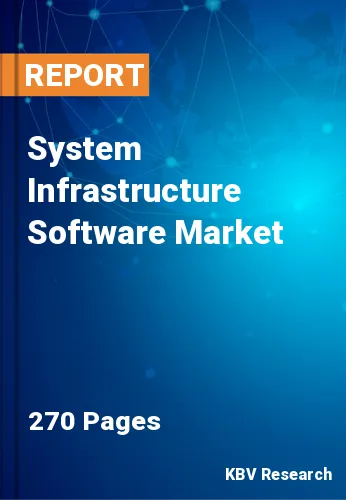
The Global System Infrastructure Software Market size is expected to reach $237.8 billion by 2028, rising at a market growth of 8.4% CAGR during the forecast period.
System infrastructure software is a business software or program made to improve an organization's IT performance. It offers businesses a range of solutions, including internal services and processes, commercial transactions, and workforce support. Many industry verticals utilize this software to run business operations quickly and effectively.
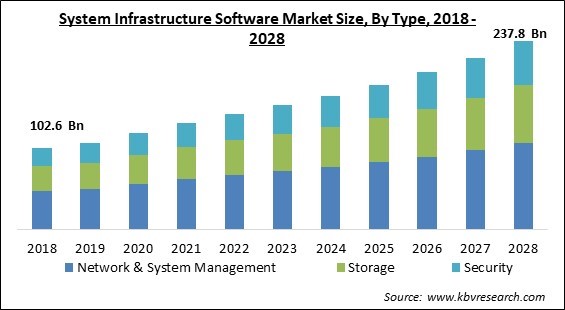
In order to connect individuals and equipment within an organization, enable optimal job performance, ensure the effective completion of business activities, share information, and handle contact points with suppliers and consumers, infrastructure software is utilized. This kind of software is more operations-related, ensuring that corporate processes and applications can continue to function properly.
This software is not related to marketing or commercial activities like the sale of goods and services. Based on their present actions and job status, infrastructure software could even be programmed to automatically notify users about best practices and pertinent discoveries. This group includes knowledge systems and expert systems.
This software is the data management and integration software that also includes data integration tools, data quality tools, and database management systems. To achieve the data consumption needs of all business processes and applications, the practice of data integration entails the architectural techniques and tools for achieving constant access and information delivery across the enterprise's range of data subject fields and types.
The tools' traditional focus was on customer data cleansing in favor of CRM-related tasks, but they have since broadened significantly, and forward-thinking businesses are starting to see their value in other domains of data. Data that normally has predetermined forms and structures are stored and organized using a database management system (DBMS), a product. The fundamental structures of DBMSs and, to a certain extent, their deployment or use, are used to classify them.
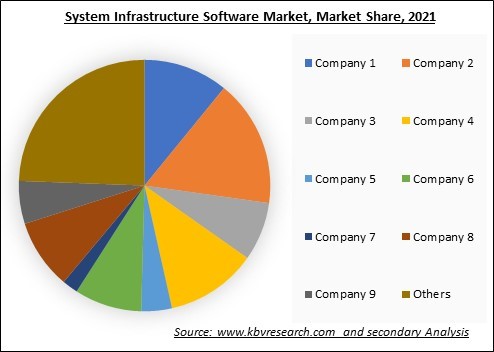
The leading players in the market are competing with diverse innovative offerings to remain competitive in the market. The below illustration shows the percentage of revenue shared by some of the leading companies in the market. The leading players of the market are adopting various strategies in order to cater demand coming from the different industries. The key developmental strategies in the market are Acquisitions.
Due to rigorous lockdown measures implemented by governments of many nations to stop the virus' spread, the emergence of COVID-19 hindered the expansion and distribution of system infrastructure software. However, the market began to experience noticeable development in early 2021 as a result of a rise in the utilization of system infrastructure software by businesses to digitize their business operations and enhance the digital experience of their customers. A few firms had already begun the transition to hybrid multi-cloud IT even prior to the pandemic, which was accelerated by the outbreak.
The quality of IT and commercial services is determined by their underlying infrastructure. Increasing user and customer satisfaction by enhancing the performance of the IT infrastructure, and delivering faster provisioning are some of the understood aspects of better customer service. Performing service-related modifications quickly and reliably and decreasing downtime through expedited maintenance operations are other aspects that are also taken care for managing cost and time effectively.
Monitoring the IT infrastructure and applications proactively allows businesses to spot issues before they become severe. IT infrastructure services allow companies to respond fast, ensuring minimal business interruptions. Additionally, businesses may limit any hazards by getting access to IT specialists. If a company is not currently regulating and monitoring the IT environment, it is likely that it would not know how it is behaving or operating unless a disaster compels the company to do so.
The vast quantities of data available presently are one of the greatest challenges for IT managers. High-performance processing of these massive data loads will require automation and virtualization to avoid hiring more personnel. For IT administrators, the main challenge is to simplify and expedite these tasks. Today, cloud technology has mostly superseded local storage. Despite being a scalable and cost-effective data storage alternative for IT administrators, system infrastructure software lacks the data storage architectures required to serve a wide variety of applications.
On the basis of type, the system infrastructure software market is segmented into storage, network & system management, and security. The security segment garnered a promising revenue share in the system infrastructure market in 2021. This is because of growing security concerns brought on by increased internet usage and infrastructure conversion to digital. Companies that use cloud platforms are largely concentrating on enhancing software security to counter evolving cyber threats like phishing, Trojans, ransomware, and distributed denial of service assaults (DDoS).
Based on application, the system infrastructure software market is divided into Building Management, Integrated Communications, Data Center Infrastructure and Cloud Integrations. The data center infrastructure segment procured the largest revenue share in the system infrastructure software market in 2021. A data center is a physical site where organizations keep their essential applications and data. The data center architecture is based on a system of storage and computing resources that allow for the distribution of shared data and applications.
By end-use, the system infrastructure software market is classified into Manufacturing, IT & Telecom, BFSI, Transportation & Logistics, Retail, Healthcare and Others. The BFSI segment witnessed a significant revenue share in the system infrastructure market in 2021. The adoption of infrastructure software in the BFSI sector is expected to grow. This is due to the shifted customer focus towards digital banking, the rise in fintech startups, as well as the propagation of technological innovations in the banking sectors, including Blockchain, Neo-Banking, Banking-as-a-Service (BaaS), and Digital Factoring.
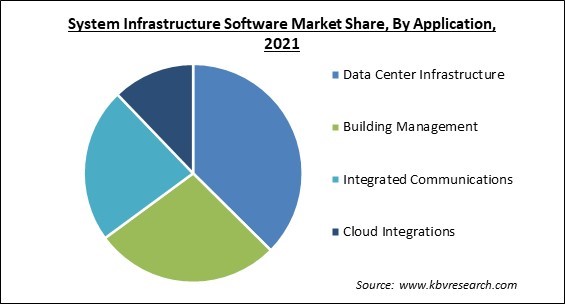
| Report Attribute | Details |
|---|---|
| Market size value in 2021 | USD 134.3 Billion |
| Market size forecast in 2028 | USD 237.8 Billion |
| Base Year | 2021 |
| Historical Period | 2018 to 2020 |
| Forecast Period | 2022 to 2028 |
| Revenue Growth Rate | CAGR of 8.4% from 2022 to 2028 |
| Number of Pages | 270 |
| Number of Tables | 403 |
| Report coverage | Market Trends, Revenue Estimation and Forecast, Segmentation Analysis, Regional and Country Breakdown, Market Share Analysis, Competitive Landscape, Companies Strategic Developments, Company Profiling |
| Segments covered | Type, Application, End-use, Region |
| Country scope | US, Canada, Mexico, Germany, UK, France, Russia, Spain, Italy, China, Japan, India, South Korea, Singapore, Malaysia, Brazil, Argentina, UAE, Saudi Arabia, South Africa, Nigeria |
| Growth Drivers |
|
| Restraints |
|
Region-wise, the system infrastructure software market is analyzed across North America, Europe, Asia Pacific and LAMEA. The North America region garnered the highest revenue share in the system infrastructure software market in 2021. The increasing number of data centers in the region are encouraging industry participants to build their own individual data infrastructure structures for processing and storing data. Additionally, the emergence of startups in the region is opening up promising new avenues in the United States and Canada, are responsible for the region's growth.
Free Valuable Insights: Global System Infrastructure Software Market size to reach USD 237.8 Billion by 2028
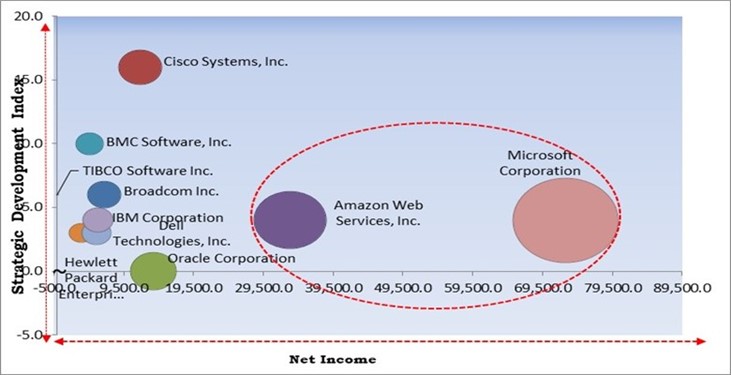
The major strategies followed by the market participants are Acquisitions. Based on the Analysis presented in the Cardinal matrix; Microsoft Corporation and Amazon Web Services, Inc. are the forerunners in the System Infrastructure Software Market. Companies such as Cisco Systems, Inc., Broadcom, Inc., IBM Corporation are some of the key innovators in System Infrastructure Software Market.
The market research report covers the analysis of key stake holders of the market. Key companies profiled in the report include Amazon Web Services, Inc., BMC Software, Inc., Broadcom Inc., Cisco Systems, Inc., Dell Technologies, Inc., Hewlett Packard Enterprise, IBM Corporation, Microsoft Corporation, Oracle Corporation, and TIBCO Software Inc.
By Type
By Application
By End Use
By Geography
The global System Infrastructure Software Market size is expected to reach $237.8 billion by 2028.
Improved Associated Customer Care And Significantly Reduced Cost And Time are driving the market in coming years, however, Insufficient Data Structure Architectures And Computing Challenges restraints the growth of the market.
Amazon Web Services, Inc., BMC Software, Inc., Broadcom Inc., Cisco Systems, Inc., Dell Technologies, Inc., Hewlett Packard Enterprise, IBM Corporation, Microsoft Corporation, Oracle Corporation, and TIBCO Software Inc.
The IT & Telecom segment acquired maximum revenue share in the Global System Infrastructure Software Market by End-use in 2021 thereby, achieving a market value of $55.7 billion by 2028.
The Network & System Management segment is leading the Global System Infrastructure Software Market by Type in 2021 thereby, achieving a market value of $109.1 billion by 2028.
The North America market dominated the Global System Infrastructure Software Market by Region in 2021, and would continue to be a dominant market till 2028; thereby, achieving a market value of $87.2 billion by 2028.
Our team of dedicated experts can provide you with attractive expansion opportunities for your business.
